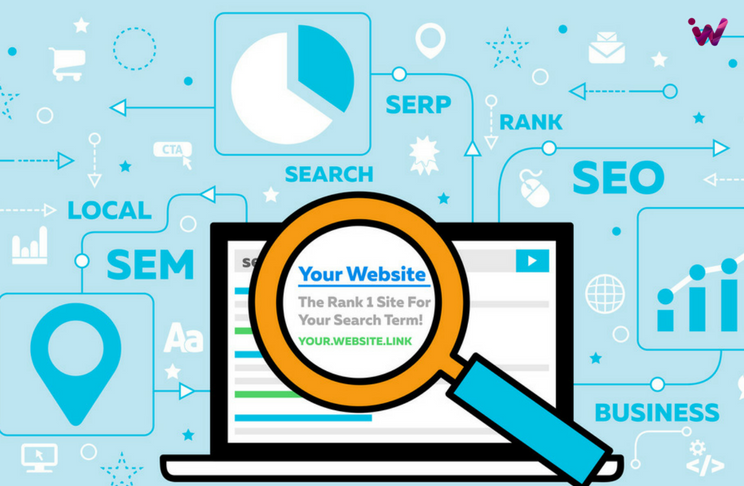Today’s consumers live in a digital world. According to Accenture, approximately 94% of B2B buyers say they search online before making a purchase.
Brands that do not take the initiative to take advantage of and understand the importance of SEO will be left behind and lose a great value that they could be adding to your business.
In the B2C sector, you can also see the predominance of the online world. Statista reports that global e-commerce is expected to reach $ 4.5 billion by 2021.
By that time, e-commerce will represent 17.5% of all retail sales, more than double what it was in 2015. In addition, GE Capital Retail Bank reports that 81% of people who investigate online before making the decision to buy something.
The digital world also affects local companies in the local search. An LSA-Acquisio report found that 75% of mobile searches result in a visit to the store within 24 hours, and 30% of these visits result in a purchase.
Modern consumers see the Internet as an integral part of their shopping experience. Regardless of whether they shop online or in person, they use the Internet to learn more about the products and businesses available.
The digital market, therefore, can not be overlooked by any business.
Investing in SEO, however, can seem overwhelming.
Companies want to know that the time and financial investment they make will give them a strong return both now and in the future. This is what every organization should know about the importance of SEO.
Understand the fundamental principles of SEO
Search engine optimization describes a strategy that covers almost every aspect of site creation and content development.
When done effectively, it creates an exceptional user experience for the consumer, which increases their confidence in the company.
The main objective of SEO is to demonstrate its value to search engines. When they know their value, their pages will have a high rank of relevant queries for their content.
The importance of SEO comes from its ability to help customers find it easily.
How search engine optimization works
Google ‘reads’ the websites available online with their spiders.
These spiders look for key information that indicates the topics and the value of the content of each web page.
Spiders, of course, can not really read. This means that they will search for certain terms and examine the organization of the site to find clues about the value of the site.
These are some of the aspects of SEO that form the basis of any strategy.
Keyword optimization
People often talk about keywords when people discuss the importance of SEO. The keywords refer to the terms you write about, trying to match the keywords that your target audience uses in searches.
It is important to realize, however, that keywords alone are not enough. Google does not want to see text that is filled with endless repetitions of the same keyword or key phrase. This text reads poorly and contributes to a poor user experience.
Instead, Google wants to see high-value keywords, but also semantic words. Semantic keywords refer to the other terms you will probably use when analyzing a particular term.
The semantic terms that he uses give Google more information about precisely what he discusses about this topic and the level of depth it offers.
Content that does not use many related keywords can be seen as superficial and does not offer the value that customers want to see.
The construction and organization of the site.
Google and its algorithm also analyze the organization of the site. A clear site map makes it easy for Google to navigate the site.
It also helps ensure that the spider does not miss any of the pages on the site while it is exploring the domain.
A clear site map and easy navigation also contribute to the user experience.
When users can easily move through their site, they get better involved with the content. It also improves your ability to convert and then become a paying customer.
A part of the construction of the site also includes the loading speed of the site.
The pages that are loaded slowly on any device will be poorly marked by Google and will also be abandoned by users who enter the site.
Brands should take the time to carefully consider how they build their site, including the images and videos they use, to be sure that everything has been created to ensure an optimal loading time.
Site errors
Site errors also negatively affect SEO.
These site errors interrupt the user’s experience and make it difficult for visitors to find the content they want to see.
Google disregards these types of errors and will damage the page rankings. Part of SEO is to run a site audit and verify that all error pages, misdirected redirects, duplicate pages and similar types of errors are removed.
A simple site audit will look like this and will tell you any errors you may have on your site.
You can run the audit of this site through a variety of different programs, but we recommend that you hire an SEO company to audit your site so they can correct it for you as soon as possible.
Mobile optimization
Of course, SEO would not be complete without a discussion about mobile optimization. Google has observed that there are now more searches on mobile devices than on desktop computers.
In response, they have updated their requirements to improve mobile optimization.
As of 2015, Google launched its call mobile Geddon update.
According to this update, the sites that were not suitable for mobile devices would be affected in the rankings.
Being ready for mobile devices can take several different forms, such as having a designated mobile site or using responsive design to adjust the site to any screen size.
Soon, Google also began to discuss the potential of a mobile algorithm first. Google announced that this update would start operating in March 2018.
Previously, Google had created its algorithm to observe first how sites appeared on desktop sites.
The search engine does not use separate algorithms for mobile and desktop devices.
With this new update, Google now looks first at the mobile construction of the website. This means that your mobile optimization will affect the rankings of your site on both mobile devices and desktops.
To succeed in this first mobile world, brands need to use mobile SEO to make sure that their content has been created correctly.
The site should be easy to navigate with your fingers. It should also be loaded on mobile devices, be easy to read and avoid pop-ups or other types of text that may interrupt the mobile user’s experience.
To fully optimize for mobile devices, brands should focus on creating sites for mobile users, instead of just creating a site that works on their devices.
Overcoming objections to SEO
The most common objections raised by companies regarding SEO revolve around the necessary time and investment.
It may take a few weeks or a few months (at least 6 months) to see actual results of an SEO initiative, which makes it difficult to find the resources to invest in optimization now.
Fortunately, there are some commercial results that brands can immediately see from an investment in SEO.
While the most significant results may take time, the positive changes observed with SEO can benefit customers, and therefore the business, immediately:
- Improve visibility as site rankings improve: As brands correct errors in their sites and select particular keywords for which they want to optimize their content, they will begin to obtain ranking positions. Although they may not reach the best SERP locations immediately, they can still increase their visibility and begin to see the improved organic performance.
- Better commitment to site users: As brands begin to pay attention to the importance of SEO and, therefore, begin to clean their websites, they will improve the user experience. It will be easier for people to move around the site and find what they need. This will improve the reputation of the site. It will also increase engagement with users and encourage more potential customers to become customers.
- Improved user experience (UX): Clearing site errors will help eliminate duplicate content, errors, or poor redirects. This will also improve the user experience.
Brands commonly feel concerned about financial investment in SEO.
Hiring several new employees can be a burden on the budget, especially when people add the tools needed to maximize site optimization. Fortunately, there are also ways to avoid this stress.
SEO agencies can give brands access to highly experienced professionals.
These partners as they are the agencies already use the main SEO tools, which reduces the need for more investment.
Since brands should not worry about additional employee salaries or benefit payments, they can also reduce some expenses.
Those who do not want to follow the route of the agency can also start with SEO with their current internal marketing team.
Providing training opportunities can help these professionals learn the basics so they can begin to build a successful site.
However, when brands analyze the importance of SEO in the long term, they will see that the benefits only multiply the longer they stay focused on the power of optimization.
As your SEO improves, the returns you receive will far exceed your initial investment.
The importance of SEO now and in the future
Brand building
Brand building can help create powerful organizations.
When people recognize their logo, colors and name with a positive reputation that precedes it, it can help create greater confidence with the prospects. SEO and digital marketing can help capitalize on this.
As I mentioned, consumers use the Internet to find solutions, products and services for weak points.
A strong online presence will build your brand and increase your market share. Your site will appear regularly for relevant searches for your organization. Clients will become familiar with your name and business.
A strong online presence will span many channels. A complete SEO strategy will involve using platforms, such as social networks.
Your brand will be present for customers throughout their digital life, improving recognition and potential customers.
Better positions in the SERP
Your position in the SERP will play an important role in the number of clicks you receive. According to the Advanced Web Ranking, the first three positions in the SERP alone receive an average of 60% of all clicks.
This means that the higher your site appears, the more results you will get from your efforts.
Focusing on the importance of SEO will help you improve your ranking.
As Google recognizes the value that your site offers users in this sector, you will get a higher rank.
SEO helps you communicate better with search engine algorithms. Your theme will be clearer for the spiders of the search engines. It will also inform the search engines about which queries will be relevant.
Customers associate higher rankings in the SERP with industry leaders.
Google’s algorithm carefully classifies the content to find the material that provides the most value to the customer and works to separate the content that people can trust from what they can not.
Customers know that Google’s algorithm usually returns the sites that will provide the best response. This generates confidence.
When he obtains some of the highest ranking positions in the SERP, he provides an excellent platform to promote himself as an industry leader and someone whom these consumers can trust.
More traffic
As you create your ranking, you will be in a better position to increase your traffic. The best SEO practices include optimizing your titles and meta descriptions to clarify your topic.
This allows your customers to know exactly what your piece offers. Customers want to know that your site will meet their needs.
Optimizing these aspects of your site will help persuade them to click.
When you combine these elements with the strongest site rankings you get through optimization, you’ll see an increase in your traffic rates. More people will come to your website.
As you introduce more people to your websites, it will also encourage more opportunities for people to become potential customers and then convert.
The importance of SEO can not be underestimated when it comes to organic revenue growth.
Higher percentage of traffic becomes leads
SEO will also increase the percentage of your traffic that becomes potential customers.
SEO focuses on understanding what potential customers want to see and then meeting those needs. Therefore, creating a solid SEO strategy will result in a site that is more suited to your target customers.
With SEO, you need to analyze your sales funnel and determine what people want to see at each stage. You can assign the people of your target customers to the stages of the buyer’s journey, and thus create more effective content.
With content that better attracts your visitors, you can guide your prospects through the sales funnel more easily.
Customers will be able to find the content they want and you will know how to pass them to the next level. This will result in a higher conversion rate in each stage.
Business growth outside the geographical limits.
With traditional marketing, companies are often limited to their immediate geographic area. You promote yourself with direct mail, radio transmission and billboards, for example, that only people who live in your area see.
With SEO, you have the opportunity to expand your reach beyond your region. You can do business with people from all over the country and to other continents.
By understanding the importance of SEO and creating an optimized site, your page can be positioned highly in SERPs for people in different locations.
When its content is relevant, it will appear regardless of whether the prospect lives next door or thousands of kilometers away.
SEO, therefore, provides your organization with more space to grow. You have the opportunity to expand your potential audience and thus increase your reach.
You can expand your business to a level that would not have been possible before.
Greater understanding of what customers want to see
Today’s customers like to know that companies understand their weak points. They want to work with companies that meet their individual needs.
Modern customers want to foster relationships with companies and not be seen as just a number.
To serve these customers, both online and offline, you want to understand your customers intimately. This means going deeper than targeting people within a particular age range.
He wants to understand the behavior of people and why they do certain actions.
Before SEO and digital marketing, companies relied on market research and basic analysis of their own merchandise.
They used market research to identify trends in their consumption habits, for example and would use sales data to see which products and services were most popular with customers.
SEO, however, offers a completely new level for the ability to understand the customer.
By paying attention to the importance of SEO, you will begin to monitor the behavior of the client on your website.
You will see your bounce rates, how often people click on your site and where they go, your rate of abandoned shopping carts and your rate of repeat customers.
Through social networks, you can listen and participate in the conversations of these consumers.
You can receive comments from both those frustrated with your organization and those who are happy. You can use this information to improve your offers.
These behaviors were significantly more difficult, if not impossible to track before the birth of SEO and measure these metrics.
The importance of SEO and the consequent monitoring of the behavior of the website improves the ability of brands to understand their customers.
The consumer’s desire for a personalized experience and the feeling that the brand cares about them as a unique individual becomes possible.
Before SEO and digital marketing, brands were limited by what they could determine from extensive market research and some behavioral analysis of their organization.
However, with SEO, they can analyze customer behavior on an intimate level, creating a much superior brand experience.
SEO requires brands to make an investment. Without immediate results, such as those that a traditional advertising campaign can produce, it can be difficult to make that leap.
As you begin to understand the long-term importance of SEO to your organization, it should be easier to take the first steps towards digital success.
The more time you invest in SEO and the more intense your dedication, the easier it will be to see how the benefits you get from this strategy easily pay for the effort you’ve made.
12 reasons why your business needs absolutely SEO
Many brands and companies know (or think they know) that they need SEO for their digital properties, and the benefits they will get from that SEO work that is being implemented on their behalf.
SEO will undoubtedly improve the search capacity and overall visibility of a website, but what other real value does it offer? Why is SEO so important?
These 12 reasons must offer some clarity, regardless of the industry or the size of the company, as to why companies need SEO to take their brand to the next level.
1. Organic search is often the main source of website traffic
Organic search is an important part of the website’s performance of most businesses, as well as a critical component of the buyer’s funnel and, ultimately, of the users to complete a conversion or commitment.
As marketers know, Google owns a significantly larger portion of the search market than its competitors like Yahoo, Bing, Baidu, Yandex, DuckDuckGo and many, many others.
That does not mean that all search engines do not contribute to the visibility of a brand, they do, only that Google owns about 75% of the search market in general.
He is the clear leader and, therefore, it is important to follow his guidelines.
But the remaining 25% of the market owned by other engines is also obviously valuable for brands.
Google, being the most visited website in the world, is also the most popular email provider in the world (with more than 1 billion users). Not to mention that YouTube is the second largest search engine.
We know that a clear majority of the world that has access to the Internet is visiting Google at least once a day to obtain information.
Being highly visible as a trusted resource by Google and other search engines will always work in favor of the brand.
A quality SEO and a high quality website carries brands there.
2. SEO builds trust and credibility
The goal of any experienced SEO is to establish a solid foundation for a beautiful website with a clean and effective user experience that is easily detectable in the search thanks to the trust and credibility of the brand and its digital properties.
Many elements enter into the establishment of authority with respect to search engines like Google.
In addition to the factors mentioned above, authority accumulates over time as a result of elements such as:
- Quality backlink profiles.
- Positive behavior of the user.
- Automatic learning signals.
- Elements and content optimized on the page.
But establishing that authority will do more for a brand than most, if not all, other digital optimizations.
The problem is that it is impossible to generate confidence and credibility overnight, as in real life. Authority is earned and built over time.
Establishing a brand as an authority requires patience, effort and commitment, but it is also based on offering a valuable product and service that allows customers to trust a brand.
3. Good SEO also means a better user experience
Everyone wants better organic rankings and maximum visibility. Few realize that an optimal user experience is an important part of getting there.
Google has learned to interpret a favorable or unfavorable user experience, and a positive user experience has become a fundamental element for the success of a website.
Clients know what they want. If they do not find it, there will be a problem. And the performance will suffer.
A clear example of how to build a solid user experience is how Google has increasingly become a response engine that offers the data searched directly in the SERPs (search engine result pages) for users.
The intention is to offer users the information they seek in fewer clicks, quickly and easily.
SEO quality incorporates a positive user experience, taking advantage of it to work in favor of the brand.
4. Local SEO means greater commitment, traffic and conversions
With the increase and growing domination of mobile traffic, local search has become a fundamental part of the success of small and medium enterprises.
Local SEO aims to optimize their digital properties for a specific neighborhood, so that people can find it quickly and easily, bringing them one step closer to a transaction.
Local optimizations focus on cities, regions and even specific states, to establish a viable medium for a brand’s messages locally.
SEO professionals do this by optimizing the brand’s website and its content, including local citations and backlinks, as well as local listings relevant to the location and business sector to which a brand belongs.
To promote participation at the local level, SEO professionals must optimize a brand’s Knowledge Graph panel, their Google My Business list and their social media profiles as a start.
There should also be a strong emphasis on user reviews on Google, as well as on other review sites like Yelp, Home Advisor and Angie’s List (among others), depending on the industry.
5. SEO affects the buying cycle
The clients do their research. That is one of the greatest advantages of the internet from the perspective of the buyer.
The use of SEO tactics to relay their messages in search of good offers, innovative products and/or services and the importance and reliability of what it offers to customers will change the game.
Without a doubt, it will also have a positive impact on the buying cycle when done correctly.
The marks must be visible in the places where people need them to establish a dignified connection.
Local SEO improves visibility and allows potential customers to find the answers and the companies that provide them.
6. The best SEO practices are always updated
It’s great to have SEO tactics implemented on a brand’s website and in its digital properties, but if it’s a short-term commitment (budget constraints, etc.) and the site is not reevaluated steadily over time, will reach a threshold where it can no longer be improved by other impediments.
The way in which the search world evolves, basically at the discretion of Google, requires constant monitoring of changes to stay ahead of the competition and, hopefully, on page 1.
Being proactive and monitoring important changes in the algorithm will always benefit brands that do so.
We know that Google makes thousands of algorithm changes per year. Stay far behind and it will be extremely difficult to resume your position. SEO professionals help you ensure you avoid this.
7. Understanding SEO helps you understand the web environment
With the ever-changing environment that is the Internet, it can be a challenge to keep abreast of changes as they occur.
But staying aware of SEO includes being aware of the main changes that take place in the search.
Knowing the Web environment, including the tactics used by other companies and local and comparable competitors, will always be beneficial for those brands.
8. SEO is relatively cheap
Sure, it costs money. All the best things do, right?
But SEO is relatively cheap in the grand scheme of things, and the reward is likely to be considered in terms of the benefit and the end result of a brand.
This is not a marketing cost. This is a true business investment.
A good SEO implementation will keep it in the market for years to come. And, like most things in life, it will only be better with the greater attention (and investment) you receive.
9. It is a long-term strategy
SEO can (and hopefully) have a notable impact in the first year of action, and many of those actions will have an impact that will last more than several years.
As the market evolves, yes, it is better to follow trends and changes closely.
But even a site that has not implemented a lot of intense SEO recommendations will improve the best basic SEO practices that are employed in an honest website with decent user experience.
And the more time, effort and budget of SEO is committed to it, the better and longer a website will be a worthy competitor in its market.
10. It is quantifiable and measurable
While SEO does not offer the easiest ROI to calculate, like paid search, it can measure almost anything with proper tracking and analysis.
The big problem is trying to connect the points in the back-end, because there is no definitive way to understand the correlation between all the actions taken.
However, it is worth understanding how certain actions are supposed to affect performance and growth, and we hope that they do.
Any good SEO will point to those improvements, so connecting the points should not be a challenge.
Brands also want to know where they were, where they are and where they are going in terms of digital performance, especially for SEO when they have a person/company that is paid to run on their behalf.
There is also no better way to show the success of SEO. We all know that data never lies.
11. SEO brings new opportunities to the light
High-quality SEO will always find a means to discover and take advantage of new opportunities for brands not only to be discovered, but to shine.
Offering quality SEO to brands means immersing an SEO team in everything that brand is.
It is the only way to really market a brand with the passion and understanding that the brand’s stakeholders have for it: to become an interested party.
The better a brand is understood, the more opportunities will arise to help it prosper. The same can be said about SEO.
12. If you are not on page 1, you are not winning the click
It’s no secret in the SEO world that if it’s not on page 1, it’s probably not in the organic search game.
A recent study shows that the top three organic search ranking positions result in almost 40% of all clicks, while up to 30% of all results on page 1 and 2 are not clicked at all.
What does this mean? Two things:
- If it’s not on page 1, it should be.
- There are still too many cases in which a user enters a search query and cannot find exactly what they are looking for.
conclusion
Implementing strong and quality SEO on the website and the digital properties of a brand will always be beneficial for that brand and its marketing efforts.


















































